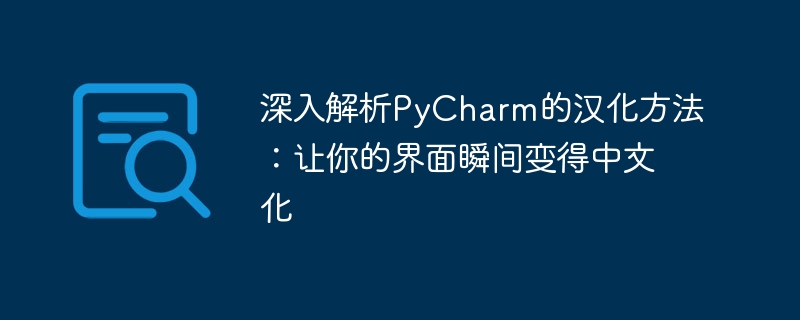
深入解析PyCharm的汉化方法:让你的界面瞬间变得中文化,需要具体代码示例
随着Python的广泛应用,PyCharm作为一款功能强大的Python集成开发环境(IDE),备受开发者的青睐。然而,PyCharm默认的界面语言是英文,对于一些非英语母语的开发者来说,可能会造成一定的困扰。所幸,PyCharm提供了汉化的功能,本文将深入解析PyCharm的汉化方法,让你的PyCharm界面瞬间变得中文化。同时,还会提供具体的代码示例,让你更好地了解如何操作。
第一步:下载适用于PyCharm的中文语言包
首先,你需要下载适用于PyCharm的中文语言包。在官方网站或者其他可信的软件下载网站上,搜索"PyCharm中文语言包"关键词,并下载最新版本的中文语言包文件。
例如,在淘宝中,可以搜索“PyCharm中文语言包”,找到可信的源提供的语言包。
第二步:安装中文语言包
下载完成后,打开PyCharm,依次点击"File" -> "Settings",进入设置界面。在设置界面的左侧导航栏中,点击"Appearance & Behavior" -> "Appearance"。
在主题界面右侧的下拉框中,选择你下载的中文语言包文件。点击"OK",PyCharm将会提示你重新启动以应用设置。
第三步:更改PyCharm配置文件
重新启动PyCharm后,你会发现界面已经成功变为中文了。不过,由于PyCharm本身没有提供中文界面的选项,这是通过更改PyCharm的配置文件来实现的。如果你希望以后打开PyCharm时默认显示中文界面,可以按照以下步骤进行操作。
首先,关闭PyCharm。
然后,找到PyCharm的安装目录,在Windows系统下,默认路径是 "C:Program FilesJetBrainsPyCharm"。进入PyCharm的安装目录后,找到"bin"文件夹,然后进入"bin"文件夹,找到"pycharm64.exe.vmoptions"(64位系统)或"pycharm.exe.vmoptions"(32位系统)文件。这个文件是PyCharm的虚拟机参数配置文件。
用记事本或其他文本编辑器打开"pycharm64.exe.vmoptions"或"pycharm.exe.vmoptions"文件,在文件的最后添加一行代码:
-Duser.language=zh
保存文件后,重新启动PyCharm,你会发现每次打开都显示中文界面了。
通过以上三个步骤,你就可以轻松地实现PyCharm的汉化,让界面瞬间变得中文化。当然,如果你有其他的语言包文件,也可以按照类似的方式进行操作。
总结:
本文深入解析了PyCharm的汉化方法,详细介绍了下载中文语言包、安装语言包以及更改配置文件的步骤。通过以上操作,你可以快速实现PyCharm界面的中文化,提高开发效率。
注意:在汉化PyCharm的过程中,请确保你下载的语言包是来自官方或可信的源,以避免安全问题。此外,随着PyCharm的更新,可能会有新版本的中文语言包发布,请定期关注官方网站或相关社区,以获取最新的中文语言包文件。
希望本文对你在PyCharm汉化方面有所帮助,祝你在中文化的PyCharm环境下愉快地进行Python开发!
以上就是PyCharm汉化方法详解:轻松让你的界面变成中文版的详细内容,更多请关注php中文网其它相关文章!

每个人都需要一台速度更快、更稳定的 PC。随着时间的推移,垃圾文件、旧注册表数据和不必要的后台进程会占用资源并降低性能。幸运的是,许多工具可以让 Windows 保持平稳运行。

Copyright 2014-2025 https://www.php.cn/ All Rights Reserved | php.cn | 湘ICP备2023035733号